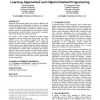956 search results - page 109 / 192 » Dimensions in program synthesis |
NECO
1998
13 years 9 months ago
1998
Support Vector Machines (SVMs) perform pattern recognition between two point classes by nding a decision surface determined by certain points of the training set, termed Support V...
HPCA
2008
IEEE
14 years 10 months ago
2008
IEEE
The continued scaling of device dimensions and the operating voltage reduces the critical charge and thus natural noise tolerance level of transistors. As a result, circuits can p...
ITICSE
2006
ACM
14 years 4 months ago
2006
ACM
Identifying and managing students who experience difficulty with learning to program is a challenge for CS educators. In an attempt to answer the familiar question “What makes f...
ATAL
2010
Springer
13 years 10 months ago
2010
Springer
One of the most challenging aspects of reasoning, planning, and acting in a multi-agent domain is reasoning about what the agents know about the knowledge of their fellows, and to...
JMLR
2012
12 years 14 days ago
2012
Sparse additive models are families of d-variate functions with the additive decomposition f∗ = ∑j∈S f∗ j , where S is an unknown subset of cardinality s d. In this paper,...

